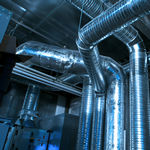Energy storage systems can temporarily store renewable or cheap heat or cold respectively and make it available again later when it is needed. The time when energy is needed and when it is produced are often not the same, which is particularly relevant to regenerative heat production.
Conventional energy storage systems store heat or cold sensibly (“perceptible”). Each energy input or output causes an increase or decrease of the temperature. Latent heat storage systems additionally use the phase transition of the storage material from solid to liquid and the other way round. During the phase transition, the storage material can absorb or release large amounts of energy at almost constant temperature. The storage capacity can be significantly increased by taking advantage of this reversible process. The container size can be significantly reduced and result in a gain of space at constant energy storage capacity. The energy input / output takes place over a long period of time at an almost constant temperature. This means that the insulation of latent storage systems can be less sophisticated and expensive.
There are different forms in which the phase change materials can be brought into the storage tank, e.g. as granules, macro capsules (packs, panels, balls, etc.), or PCM fluids (Slurry) suitable for pumping. The available heat transfer area is crucial for the performance of the storage system.
The melting temperature of the phase change materials can be individually adapted to the respective application. This allows for a multitude of applications in the entire field of heat and cold technology.





